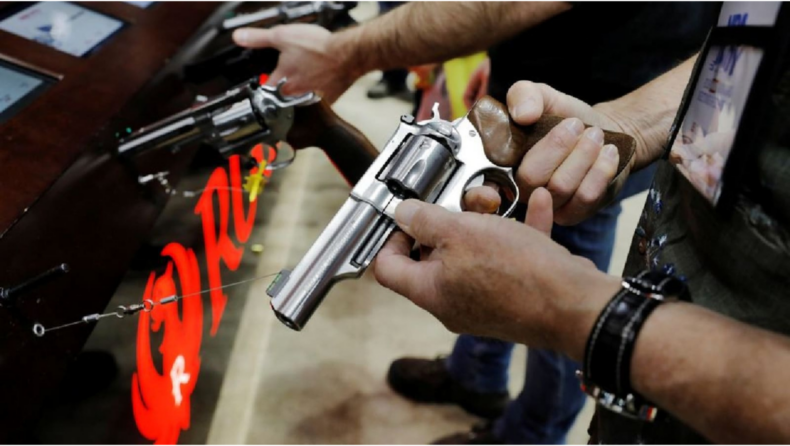Shinzo Abe seriously wounded in a shooting on Friday that was reportedly carried out with a handmade gun when he was campaigning for the ruling Liberal Democratic Party in Nara, a city east of Osaka.
The former prime minister of Japan, was shot dead. It is a testament to how rare and alarming gun violence is in a country, where gun ownership is tightly controlled.
Shinzo Abe seriously wounded in a shooting on Friday that was reportedly carried out with a handmade shotgun when he was campaigning for the ruling Liberal Democratic Party in Nara, a city east of Osaka.
Prior to this weekend’s Upper House elections, Abe was delivering a speech in front of a railway station. He was unconscious when he was brought to a nearby hospital.
“It was shocking, I never thought such a catastrophe could happen in a rural town,” said Yuki Ito, 42, who was shopping at a nearby pharmacy when Abe was shot. “It happened in the office, in the banks and in the malls, it was very safe. I was shocked to learn that it was a gun crime.”
In the island country, shootings are rare but not unheard of. According to the National Policy Agency, there were ten instances last year, one of which resulted in a fatality and four others in injuries. Weapons purchases by civilians, primarily sporting or hunting rifles and shotguns, are subject to a rigorous licence and background check procedure. Handguns are typically used by police officers.
Tetsuya Yamagami, 41, was revealed as the shooter of Abe by Japanese media. The government’s Security Police, tasked with defending important lawmakers and bureaucrats, swiftly apprehended him. Abe had a security detail as a former prime minister, and at least one of them had a shield that could deflect bullets. A hastily constructed weapon that seemed to be two long tubes tied together with black tape was shown on television broadcasts.
Daniel Foote, a professor at the University of Tokyo who specialises in law and society, said: “This actually indicates the extent to which Japan gun restrictions are working.” “Only a very small number of individuals are capable of making such a weapon.”
Less than a week ago, a Fourth of July parade outside of Chicago was the scene of a deadly mass shooting in which Robert “Bobby” Crimo III, 21, was charged with seven counts of first-degree murder. According to the Gun Violence Archive, there have been more than 300 mass shooting events in the US in 2022.
Last year, there were no gun-related incidents in Tokyo.
According to GunPolicy.org, the predicted total number of firearms owned by citizens in Japan in 2019 was 310,400, or 0.25 per 100 inhabitants, the lowest rate among the G-7 nations. Comparatively, there are 393 million firearms in the US, or 120 per 100 people, and 3.2 million in the UK, or 5 per 100 people.
William Cleary, a criminal law professor at Hiroshima Shudo University, stated that because this kind of shooting is so uncommon in Japan, it was simple to carry out. He said that on Friday, he postponed a lesson after entering and observing his classmates’ “extremely dismal” expressions. Security was plainly lax, and this will lead to tighter security, especially for open-air addresses considering that elections are currently taking place.
Tsuyoshi Inukai, the prime minister, was assassinated in office in 1932 by Navy personnel attempting to start a conflict with the US (they also originally sought to kill Charlie Chaplin, who was visiting Japan at the time). The latest politician to be shot and killed in Japan was in 2007, when the mayor of the southern city of Nagasaki was ambushed outside a train station.
Nobusuke Kishi, a previous prime minister and Abe’s maternal grandfather, was the target of another assassination attempt. In 1960, a man associated with right-wing organisations assaulted and stabbed Kishi in the course of his final days in government. He got by.
The country’s longest-serving prime minister also sought to increase defence spending and change the pacifist constitution, moves that were viewed as controversial both inside and outside of Japan. He is best known for “Abenomics,” a plan to revive Japan’s economy through unprecedented monetary easing and regulatory reform.
There is still another similarity between the two attacks on prime ministers, which occurred nearly a century apart. According to regional station FNN, Yamagami, who is accused of opening fire on Abe on Friday, was a former member of the Maritime Self-Defense Force.
Senior LDP member Hiromichi Watanabe said in a speech at the party’s headquarters, “This comes as a grave shock.” “I find it unbelievable that such a thing could occur in Japan.”
Read More-
- A chronology of former Japanese Prime Minister Shinzo Abe’s career
- The rupee descent to successive record lows pits RBI against a bearish market
- Number of undernourished folks in India declines to 224.3 million; obesity among adults on the rise: UN report
- Twitter Files A Plea For Judicial Review Of Indian Removal Orders
- UN Ocean Conference 2022-Transparency, Technology, and Illegal, Unreported and Unregulated Fishing












